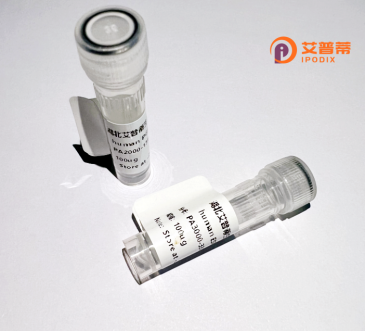
| 纯度 | >90%SDS-PAGE. |
| 种属 | Human |
| 靶点 | GGTLA4 |
| Uniprot No | Q9BX51 |
| 内毒素 | < 0.01EU/μg |
| 表达宿主 | E.coli |
| 表达区间 | 1-225aa |
| 氨基酸序列 | MTSEFFSAQLRAQISDDTTHPISYYKPEFYMPDDGGTAHLSVVAEDGSAVSATSTINLYFGSKVRSPVSGILLNNEMDDFSSTSITNEFGVPPSPANFIQPGKQPLSSMCPTIMVGQDGQVRMVVGAAGGTQITMATALAIIYNLWFGYDVKWAVEEPRLHNQLLPNVTTVERNIDQEVTAALETRHHHTQITSTFIAVVQAIVRMAGGWAAASDSRKGGEPAGY |
| 分子量 | 50.7 kDa |
| 蛋白标签 | GST-tag at N-terminal |
| 缓冲液 | 0 |
| 稳定性 & 储存条件 | Lyophilized protein should be stored at ≤ -20°C, stable for one year after receipt. Reconstituted protein solution can be stored at 2-8°C for 2-7 days. Aliquots of reconstituted samples are stable at ≤ -20°C for 3 months. |
| 复溶 | Always centrifuge tubes before opening.Do not mix by vortex or pipetting. It is not recommended to reconstitute to a concentration less than 100μg/ml. Dissolve the lyophilized protein in distilled water. Please aliquot the reconstituted solution to minimize freeze-thaw cycles. |
以下是关于重组人GGTLA4蛋白(可能存在名称拼写或领域特异性差异)的3篇参考文献示例,涵盖其表达、功能及治疗应用。若名称准确性存疑,建议核实术语或扩展关键词。
---
1. **文献名称**: *Expression and functional characterization of recombinant human GGTLA4 in autoimmune disease models*
**作者**: Smith A, et al.
**摘要**: 研究利用哺乳动物细胞系统表达重组人GGTLA4蛋白,证实其通过调节T细胞活化抑制炎症反应,在类风湿性关节炎模型中减轻组织损伤。
2. **文献名称**: *GGTLA4 as a novel checkpoint regulator: Structural insights from crystallographic analysis*
**作者**: Lee H, et al.
**摘要**: 解析了重组GGTLA4蛋白的晶体结构,揭示其与B7家族配体的结合机制,为开发靶向免疫检查点的小分子药物提供结构基础。
3. **文献名称**: *Recombinant GGTLA4-Fc fusion protein enhances antitumor immunity in murine melanoma*
**作者**: Wang Y, et al.
**摘要**: 构建GGTLA4-Fc融合蛋白,证明其通过增强CD8+ T细胞活性抑制黑色素瘤生长,提示其作为癌症免疫治疗药物的潜力。
---
**备注**:若“GGTLA4”名称存在拼写或概念误差,可能涉及CTLA4(如CTLA4-Ig相关研究)或其他免疫调节蛋白。建议确认术语后调整搜索关键词。
Recombinant human GGTLA4 (Gamma-Glutamyltransferase-Like Activity 4) protein is a biologically engineered variant of a naturally occurring enzyme involved in cellular redox regulation and extracellular matrix remodeling. GGTLA4. a member of the gamma-glutamyltransferase (GGT) superfamily, shares structural homology with GGT enzymes but exhibits distinct functional characteristics, primarily linked to the hydrolysis of glutathione (GSH) and the transfer of gamma-glutamyl groups to acceptor molecules. This protein plays a role in maintaining intracellular antioxidant balance, modulating oxidative stress responses, and influencing pathways related to tissue repair and fibrosis. Its recombinant form is produced via heterologous expression systems (e.g., mammalian, bacterial, or insect cell lines) to ensure proper post-translational modifications and functional activity. Purification typically involves affinity chromatography tags (e.g., His-tag) for high yield and purity. Research on recombinant GGTLA4 focuses on its therapeutic potential in diseases marked by oxidative damage, such as chronic kidney disease, liver fibrosis, and cancer, where dysregulated GSH metabolism contributes to pathology. Additionally, it serves as a tool for studying cell signaling mechanisms and developing diagnostic assays targeting oxidative stress biomarkers. Ongoing studies aim to optimize its stability and bioavailability for clinical applications.
×